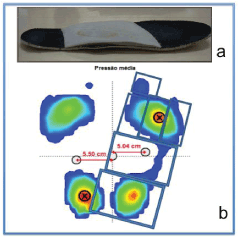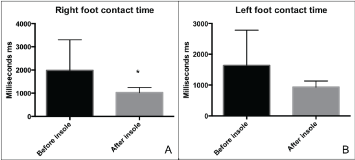Keywords
|
| Neuropathic feet; Leprosy; Ulcers; Insoles; Baropodometry |
Introduction
|
| Leprosy is a slow evolution disease caused by the bacillus Mycobacterium leprae causing a specific inflammation, which affects the peripheral nervous system with special attention to sensory fibers [1]. Neuropathy due to leprosy presents acute and sub acute inflammatory processes, depending on the extent of the infection, with different clinical presentations and treatments, also with lepromatous reactions and consequent complex handling [2,3]. Thus, the nerve damage could cause motor and sensitive changes that leads to various degrees of disability. This results in interference on social and economical life of the patients, as well as stigma and discrimination against them [4]. |
| The injury of sensory fibers leads to patient’s loss of thermal, tactile and pain sensitivity. The injury of autonomic fibers causes alteration of glandular functions, resulting in dry skin and weakness of mucous membranes [2]. Damaged motor peripheral fibers are responsible for the decrease or absence of muscle response, which can lead to muscle paralysis or atrophy [5]. |
| The most commonly affected nervous branches by leprosy are the ulnar and common peroneal, the latter being responsible for gait in its early stages (dorsiflexion prior to heel contact instance) and during unilateral weight-bearing phase (maintenance of the lateral arch support and stability). The common peroneal nerve injury and plantar sensory deficit can also interfere with body balance control by compromising the feedback of the interaction between ground and feet, thus resulting in foot deformities such as the weakness of dorsal flexors (anterior tibial muscle), and weakness of inverters and everter of the midfoot (posterior tibial and fibular muscle). The fall of the transverse arch of the foot can be observed in a leprotic feet, along with the exposure of plantar metatarsal heads and the onset of claw toes. These deformities are known to cause calluses and plantar ulcers in neuropathic feet [6-8]. It has been observed that 32% of leprosy patients present skin ulceration, and the incidence of plantar ulcers specifically for these patients ranges from 20% to 70% [9,10]. |
| The Baropodometer is a clinical tool consisting of a polycarbonate board with calibrated pressure sensors that identify sites of plantar overpressure (in kPa) both in static position and gait, and record time of total foot contact (in milisseconds) and contact area (cm) for each step. The results are shown on the computer screen: each activated sensor is labeled with colors according to the pressure recorded, and numeral results are shown alongside the image. This device is well accepted clinically because it is noninvasive and presents relatively low cost to the Health Service [11,12]. |
| The treatment of foot deformities for leprosy patients in Brazil includes the use of customized insoles, handmade according to the alteration in sensitivity and ankle position (protocol of the Brazilian Ministry of Health [13]). Clinically, it has been observed the remission of plantar ulcers using these insoles in patients treated at the National Reference Center for Sanitary Dermatology of the Hospital of Ribeirao Preto Medical School, University of Sao Paulo (CRNDS-HCFMRP-USP), but there are no scientific studies proving its effectiveness regarding the reduction of plantar peak pressures. |
Objective
|
| To observe the influence of the use of metatarsal plantar support type of insole in leprosy, through tests using a baropodometric device during gait and static position. |
Methodology
|
| Ten leprosy patients undergoing drug treatment at the CRNDSHCFMRP- USP with previous history of plantar protective sensory impairment were randomly selected. The patients were submitted to the Semmes-Weinstein sensory test and were considered eligible to the study if didn’t respond to the purple monofilament stimuli (10 g) at 3 or more plantar sites on each foot [6]. Patients presenting other neurological diseases that could alter plantar sensitivity, such as Diabetes, or presenting orthopedic or neurologic diseases other than Leprosy that could affect free gait, or patients wearing assistive walking devices were not qualified for this study. The volunteers signed a consent form agreeing to participate on the study, and were told to stand barefoot in a static position with arms relaxed and opened eyes for 30 seconds on the Baropodometer (Footwork-ISP Informatique®, France). They were then conducted to the walking test on the same device, also barefooted, where they were asked to walk through a path 5 meters long, with the Baropodometer positioned halfway from the start position. After these first tests, an insole with metatarsal plantar support (Figure 1a) was tailor made for each foot (as indicated by the Brazilian Ministry of Health), and the Baropodometry tests redone after a period of 10 months. |
| Each image of the foot provided by the Baropodometer was divided into 7 plantar areas as shown: |
| 1-halux; |
| 2-first metatarsal head (1MTH); |
| 3-third metatarsal head (3MTH); |
| 4-fifth metatarsal head (5MTH); |
| 5-midfoot; |
| 6-heel; |
| 7-total plantar support (TPS). |
| The peak pressures (kPa) were recorded separately during standing position (Figure 1b) and the plantar contact time (milliseconds-ms) was recorded during gait for each foot. All data were statistically analyzed by the GraphPad® software (paired t-test) to compare the values obtained before and after the usage of the insoles. It is important to consider that all measurements were taken with the subjects barefooted, to observe whether the insoles could influence an adaptation to pressure peak distribution or gait speed after 10 months. |
Results
|
| Data were collected from 10 leprosy patients under treatment at CRNDS-HCFMRP- USP being 6 men and 4 women ageing 25 to 60 years (mean 42, 5 ± 24, 7sd). The data obtained from the baropodometry were statistically analyzed and revealed pressure changes before and after the usage of insoles (Tables 1 and 2; Figure 2a and 2b). |
| The data collected of plantar pressure peaks during standing position showed that Halux, 1MTH, 3MTH, 5MTH and heel areas had increased values both for right and left feet, while the Midfoot area showed maintenance of the plantar pressure for right and left foot. The data collected from Total Plantar Support showed maintenance of pressure peaks on the left foot while it increased on the right foot of the subjects after a period of 10 months. |
| Although these findings might be fairly visible on the charts, there was no statistical correlation (p value <0.05) between the data found before and after the usage of insoles for all plantar areas observed during standing position. |
| The data collected during gait, however, showed a significant reduction in Contact Time of the right and left foot, but a statistically significant correlation could only be observed on the right foot after the use of insoles (Figure 3). |
Discussion
|
| The patient with leprosy suffers stigma and prejudice on daily basis, even after the development of clinical treatment and expressive remission of its disabling symptoms. Plantar sensory impairment has been a challenge for the patient, who needs daily preventive care as well as multidisciplinary support. Maladapted shoes, uneven pavements, several working hours with no footrest, are factors that worsen neuropathic foot condition and hinder the prevention of plantar ulcers [8]. In this sense, there is an effort of the Public Health Care System in Brazil to adapt shoes and make insoles more fitted to the reality of the patients, but much of these adaptations come from the knowledge of clinical observation, without scientific basis [6,9,13,14]. |
| The use of customized insoles helps reducing 14% or more plantar pressure peaks and increases the contact area of the diabetic foot to the ground, which is an important issue since the steps for the formation of ulcer in diabetic foot includes neuropathy, foot deformity and trauma [15]. |
| When it comes to patients with leprosy, there is a correlation between plantar ulcers, areas of protective sensory loss, and increased plantar pressure peaks [12]. The use of insoles has been found to reduce pressure peaks while wearing them [11], but nothing has been described showing how the foot might adapt to the modifications the insoles or shoes might impose through time. |
| The results obtained in this study showed that after 10 months wearing insoles there was no significant change in plantar pressure peaks in all seven areas selected for static analysis, contrary to what was expected. On the other hand, there was an increase in gait speed of these patients, an indicative of gain in independence and improved body balance [16]. |
| Nerve injury resulting from leprosy occurs heterogeneously in the plantar region, which may lead to anomalous usage of muscle groups to maintain body balance, since the plantar sensory outputs are part of the balance control mechanism, along with eyes and the vestibular system [17,18]. The studies relating body balance control and plantar sensitivity reported an alternate muscle recruitment for maintaining the body in an upright position when there is a change in one or more regulators of the postural control such as eyes, plantar surface or vestibular system. Also, it has been noticed that a faster walking speed leads to more independency to perform chores inside and outside their home. When it comes to daily activities performed by patients with leprosy, it has been proved by the BESTest-balance evaluation that sensory loss on foot and hands could be related to a bad performance in postural control [19,20]. |
Conclusion
|
| Therefore, it can be inferred by these results that the continous use of an insole is not enough to generate muscle adaptations in favor of reducing plantar pressure peaks of the Leprosy patient, which corroborates to the importance of the follow up of this patient, even after clinical discharge. |
| Furthermore, it was found that the continuous use of an insole with metatarsal plantar support reduces the contact time of bony prominences and insensitive areas and might help to prevent and / or cure plantar ulcers as observed in clinical care. |
| Taken the relevance of these findings, we suggest the continuation of this study with greater attention to the patient's body balance control during gait. |
Acknowledgements
|
| The authors would like to thank the nurse staff of the CRNDSHCFMRP- USP and the orthoses technicians for their support and wonderful job with the Leprosy patients. |
Tables at a glance
|
 |
 |
| Table 1 |
Table 2 |
|
| |
Figures at a glance
|
 |
 |
 |
| Figure 1 |
Figure 2 |
Figure 3 |
|
| |








